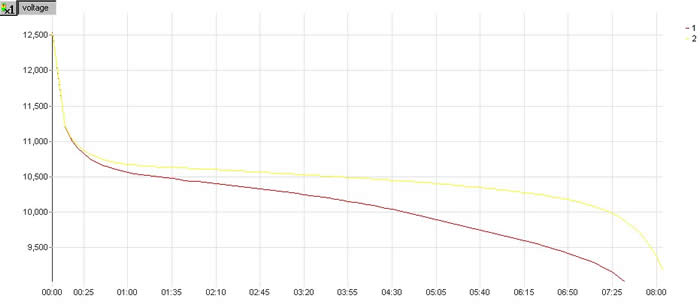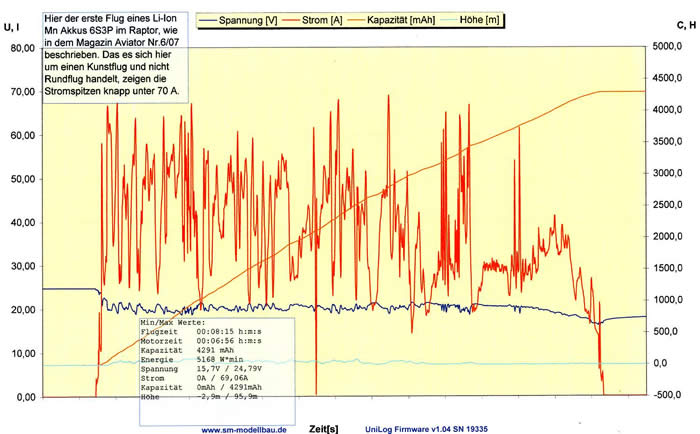
Grosse Twiete 50
D-25499 Tangstedt
Telefon: +49 (0) 4101 / 5912 - 15
Telefax: +49 (0) 721-151-478379
Email: info@first-products.de
www.first-products.de
bestellung@first-products.de
|
Grosse Twiete 50 D-25499 Tangstedt Telefon: +49 (0) 4101 / 5912 - 15 Telefax: +49 (0) 721-151-478379 Email: info@first-products.de www.first-products.de bestellung@first-products.de |
This cell offers a new Mangan technology. The cells are mechanically and electrically robust. Life time to 80 % of the original capacity
is over 200 cycles. Energy density is far better than with NiMH cells and there is no memory effect and very low self discharge. The
most important advantage is the fast charge capability at 4,5 Ampere, thus the cells reach 97 % of their capacity in only 30 minutes.
Those who cannot wait to fly again, may use the Fast Li-Po charge modus of the Pulsar 2 and only after 16 minutes 85 % of the capacity
is available (ca. 1200 mAh).
These new Mangan cells are inherently safe and very tolerant with overcharging and discharge cut off voltage.Thus the complete capacity
of these cells can be exploited. Your motor controller does not have to have a LiPo switch off capability. Like with the NiCd cells, when you
feel the voltage drops, it is time to land.
The cell offers 20 Ampere continuous discharge current and 28 Ampere peak current for up to 10 seconds. As valid for other Lithium
cells, these Mangan cells like it hot. The best efficiency is offered at a temperature of 40 degrees Celsius.
The accu packs are to be charged in Li-Po mode of your charger. Charge voltage is 4,2 Volts, as with LiPo accus.
These Mangan cells are charged without a balancer since they have no voltage drifting.
Nominal voltage: 3,8 V Nominal capacity: 1400mAh Weight: 42,6 g; Dimensions: Ø 18,5 mm und length 65 mm
The cells have been tested in these models:
Lama Ko-axial Heli, 2S1P, 14 min flying time; Logo 20, 8S3P, 14 min flying time; lots of park- and fun flyers with 3S1P.
Mini Ellipse and Banana-E with 4S1P, 16 climbs at 20 m/s (climb rate) to 200 m; Multiplex FunJet with 3S3P, 12 min pure fun;
Excel Competion 3, 3S3P, 18 climbs to 200 m, flying time> 60 min. In all these applications the cells never reached a temperature
over 60 degrees Celsius..
The packs are assembled in Germany. The packs come with either 1,5 mm² Siliconkabel (1P) or 2,5 mm² Siliconkabel (2P+).
Have a look at the test packs below.
|
|
|
|
|
 |
||
|
3S1P 11,4V |
4S1P 15,2V |
2S1P 7,6V for Lama |
3S2P 11,4V for Belt CP |
2 x 4S3P for Logo 20 |
||
We assemble any accupack to your specs without extra cost.
Price for 1 to 9 cells is 11,50 €, for 10 to 19 cells 11,00 €, for 20 to 49 cells 10,50 €, and for over 50 cells 10,00 € for cell in readily assembled packs
|
|||||||
Discharge rate "C"
More and more cells are advertised using the discharge rate "C". Today, this goes up to 30 C!
I assume, that pilots of model airplanes and helicopters at least want a flying time of 6 minutes. That means that the average current
should be equal or less than 10 C. (Please have a look at the table below)
This is true for any type of accu.
Average discharge Discharge time
current in C in minutes
5 C 12 min
7,5 C 8 min
10 C 6 min
15 C 4 min
20 C 3 min
25 C 2,4 min
30 C 2 min
A 2 kg aerobatic model requires 400 Watts input for the straight up flight elements, but only 84 Watts for level flight.
For a 3S2P Accu with 11,4 Volt and 2800 mAh this means a peak current of 40 A (ca. 14 C) for the straigth up flight
elements and 8 A (ca. 3 C) for level flight. The average current is 20 A (7 C), allowing a flying time of over 8 minutes.
These requirements are easily met by a 3S2P accupack, since for most of the time, it will operate in its optimal operating
range around 10 C and only weighs 270 g.
A completely different picture is the use in electric gliders, especially in hotliners. In this application the accupack has to deliver
a maximum current up to 10 seconds for the climb. This impuls(over)load is acceptable, because the accupack is able to regenerate
itself within the following break.
We have simulated this application, 10 seconds load of 28 A (20 C) followed by a 60 second break using a 3S1P accupack.
| Testreport | ||||||
| Accu: | First Connect Li-Ion Mn 1400 mAh, 3S1P, 11,4 V | |||||
| Ambient temperature 20 Degrees Celsius | ||||||
| Testprogram: Hotliner 10 seconds 28 A (20 C) then 60 seconds break, etc. | ||||||
| Accu temperature at beginning of discharge: | 23 Degrees Celcius | |||||
| Meter: Hyperion E-Meter | Load: Brushless Outrunner | Controller: Jeti/Hacker | ||||
| Cycle | Voltage | temperature | Capacity | Delta mAh | Run time | Volt per cell |
| Volt | degr. Celsius | mAh | seconds | Volt | ||
| 1 | 9,32 | 26,7 | 70 | 70 | 9,0 | 3,107 |
| 2 | 9,61 | 31,8 | 152 | 82 | 10,5 | 3,203 |
| 3 | 9,66 | 36,7 | 232 | 80 | 10,3 | 3,220 |
| 4 | 9,68 | 38,6 | 320 | 88 | 11,3 | 3,227 |
| 5 | 9,73 | 39,1 | 412 | 92 | 11,8 | 3,243 |
| 6 | 9,73 | 40,5 | 490 | 78 | 10,0 | 3,243 |
| 7 | 9,75 | 44,7 | 578 | 88 | 11,3 | 3,250 |
| 8 | 9,77 | 46,2 | 657 | 79 | 10,1 | 3,257 |
| 9 | 9,73 | 46,3 | 745 | 88 | 11,3 | 3,243 |
| 10 | 9,68 | 47,2 | 833 | 88 | 11,3 | 3,227 |
| 11 | 9,61 | 48 | 920 | 87 | 11,2 | 3,203 |
| 12 | 9,48 | 49,1 | 1006 | 86 | 11,0 | 3,160 |
| 13 | 9,38 | 50,1 | 1090 | 84 | 10,8 | 3,127 |
| 14 | 9,26 | 51,2 | 1176 | 86 | 11,0 | 3,087 |
| 15 | 9,01 | 51,8 | 1267 | 91 | 11,7 | 3,003 |
| 16 | 8,65 | 54,1 | 1354 | 87 | 11,2 | 2,883 |
| Average | 9,50 | 10,85 | 3,17 | |||
That accupack delivers 16 climbs. Discharge capacity is 1354 mAh and the temperature without any
cooling stays well below 60 degrees Celsius.
| Comparison LiPo 3S1P and Li-Ion Mn 3S2P | |||||
| Unit | LiPo | Li-Ion Mn | Li-Ion/LiPo | ||
| Capacity | mAh | 3200 | 2800 | 88% | |
| Accupack | 3S1P | 3S2P | |||
| Nominal Voltage | V | 11,1 | 11,4 | 103% | |
| Max. Discharge current | A | 64 | 56 | 88% | |
| Weight | g | 270 | 270 | 100% | |
| Available capacity *) | % | 75 | 95 | ||
| mAh | 2400 | 2660 | 111% | ||
| Voltage during disch. | constant | constant | |||
| Energy@20A | Wh | 25,9 | 28,7 | 111% | |
| Fast charge *) | C,A | 1,5 C = 4,8 A | 3,2 C = 9 A | ||
| Charge time | min | >60 | 30 | ||
| Balance, Equalize | always | never | |||
| Lifetime@10C | Zykl. | ?200? | >200 | ||
| Price | € | 110 | 63 | 57% | |
| Cost per cycle | € | 0,55 | 0,315 | 57% | |
| *)Lipo discharge to 25 % of the nominal capacity to gain life time. Max charge for same reason | |||||
| only with 1,5 C.. Li-Ion Mn are inherently safe at discharge and can be charged with 3.2 C. | |||||
Finally the comparison of the discharge curves of the FC Li-Ion Mn (yellow) and the
Konion 1300 (red) at a discharge current of 9,9 A with the Pulsar 2 discharge mode..

Below you see the data from a flight with the helicopter Raptor from ThunderTiger using a 6S3P accupack.
This was an aerobatic flight. 20 times the current peaks over 60 amps. Nevertheless the accupack delivered
4291 mAh and the voltage did not drop a bit until the end of discharge.
